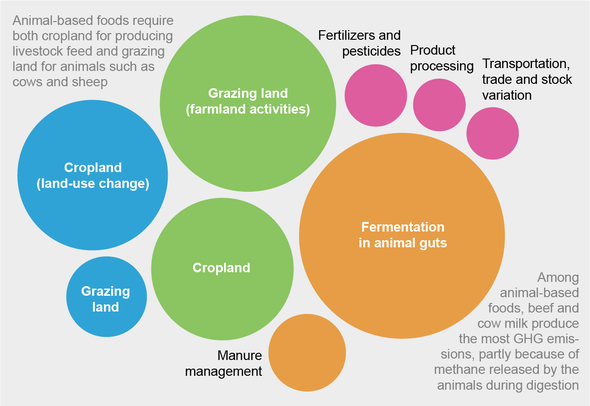Here Is How Much Food Contributes to Climate Change
Likewise with most things identified with individuals, the food we eat accompanies a carbon cost. Soil culturing, yield and animals transportation, compost the executives and the wide range of various parts of worldwide food creations to the tune of in excess of 17 billion metric tons each year, as per another review distributed on Monday in Nature Food. Creature based food varieties represent 57% of those discharges, and plant-based ones make up 29%. The analysts trust the paper's itemized breakdown of how much each farming practice, animal item, harvest and nation adds to fossil fuel byproducts can help concentration and calibrate decrease endeavors.
However past examinations have assessed emanations from agribusiness, the creators say this work is more nitty gritty and far reaching. It utilizes information on 171 yields and 16 creature items from in excess of 200 nations, alongside PC demonstrating, to ascertain the measures of carbon dioxide, methane and nitrous oxide that are contributed by individual components of the worldwide food framework, including utilization and creation. Assuming we need to control those outflows, "we expected to compute a decent gauge," says concentrate on co-creator Atul Jain, an environment researcher at the University of Illinois at Urbana-Champaign.

The outcomes line up with other examination, says Liqing Peng, a food and horticulture modeler at the not-for-profit World Resources Institute, which distributed its own in 2020. The new review's gauge of absolute outflows is on the higher side of the scope of past ones, she says. This is mostly on the grounds that it remembers information for farmland the executives rehearses, like water system and planting, just as exercises past the ranch, like handling and bundling—numbers which are hard to acquire. "Get as itemized as conceivable on these breakdowns" to realize where to focus outflows decrease examination and arrangements, Peng adds.
Of the food items the review analyzed, hamburger creation was the top outflows patron well beyond what might be expected, representing 25% of the aggregate. Among creature based items, it was trailed by cow milk, pork and chicken meat, in a specific order. In the class of yields, rice cultivating was the top donor—and it was the second-most elevated patron among all items, representing 12% of the aggregate. Rice's generally high positioning comes from the methane-delivering microbes that flourish in the anaerobic states of overwhelmed paddies. After rice, the most elevated outflows related with plant creation came from wheat, sugarcane and maize.
Concerning commitments from individual locales, South and Southeast Asia included the general top producer of ozone harming substances identified with food creation and the main district where plant-based emanations were higher than creature based ones due to rice development. Among nations, China, India and Indonesia had the most noteworthy plant-based food creation emanations. This, once more, was connected to rice ranches, just as enormous populaces that encourage an exorbitant interest for food—which drives more change of land to farming creation. In view of their enormous populaces, these regions enrolled somewhat low per capita creation outflows. The most noteworthy per capita outflows (and the second-most noteworthy territorial emanations generally) were found in South America due to its moderately huge creation of meat, especially hamburger. North America had the second-most noteworthy per capita creation emanations, trailed by Europe.
The concentrate likewise separated outflows brought about by different parts of food creation and utilization. Ranch exercises, like furrowing soil or utilizing different sorts of hardware—alongside the change of land from woods or other normal scenes into field and cropland—on the whole represented 66% of outflows.
Jain and his associates need to utilize these outcomes, alongside PC demonstrating, to look at how changing farmland the executives (diminishing compost use or utilizing no-work soil techniques, for instance) could decrease emanations. They additionally need to concentrate on the best way to adjust the food prerequisites of a developing worldwide populace with the need to stop deforestation. "That is the reason we put such a lot of exertion" into being so exhaustive in the new paper's bookkeeping, Jain says. His co-creator Xiaoming Xu, likewise at the University of Illinois at Urbana-Champaign, is hopeful with regards to the possibilities of making a scratch in food-based discharges. "I think there are a great deal of choices we can do," he says. Yet, Peng takes note of that gathering the current—and goal-oriented—worldwide outflows decrease targets will mean sorting out which approaches bode well as well as give the greatest bang to the buck as far as getting results. "You need to do everything," she says, "yet you can't do everything simultaneously."

Electronic-terrorism, voice to skull and neuro monitoring on Hive and Steem. You can ignore this, but your going to wish you didnt soon. This is happening whether you believe it or not. https://ecency.com/fyrstikken/@fairandbalanced/i-am-the-only-motherfucker-on-the-internet-pointing-to-a-direct-source-for-voice-to-skull-electronic-terrorism
Congratulations @katirayo! You have completed the following achievement on the Hive blockchain and have been rewarded with new badge(s) :
Your next target is to reach 60 posts.
You can view your badges on your board and compare yourself to others in the Ranking
If you no longer want to receive notifications, reply to this comment with the word
STOPTo support your work, I also upvoted your post!
Check out the last post from @hivebuzz: